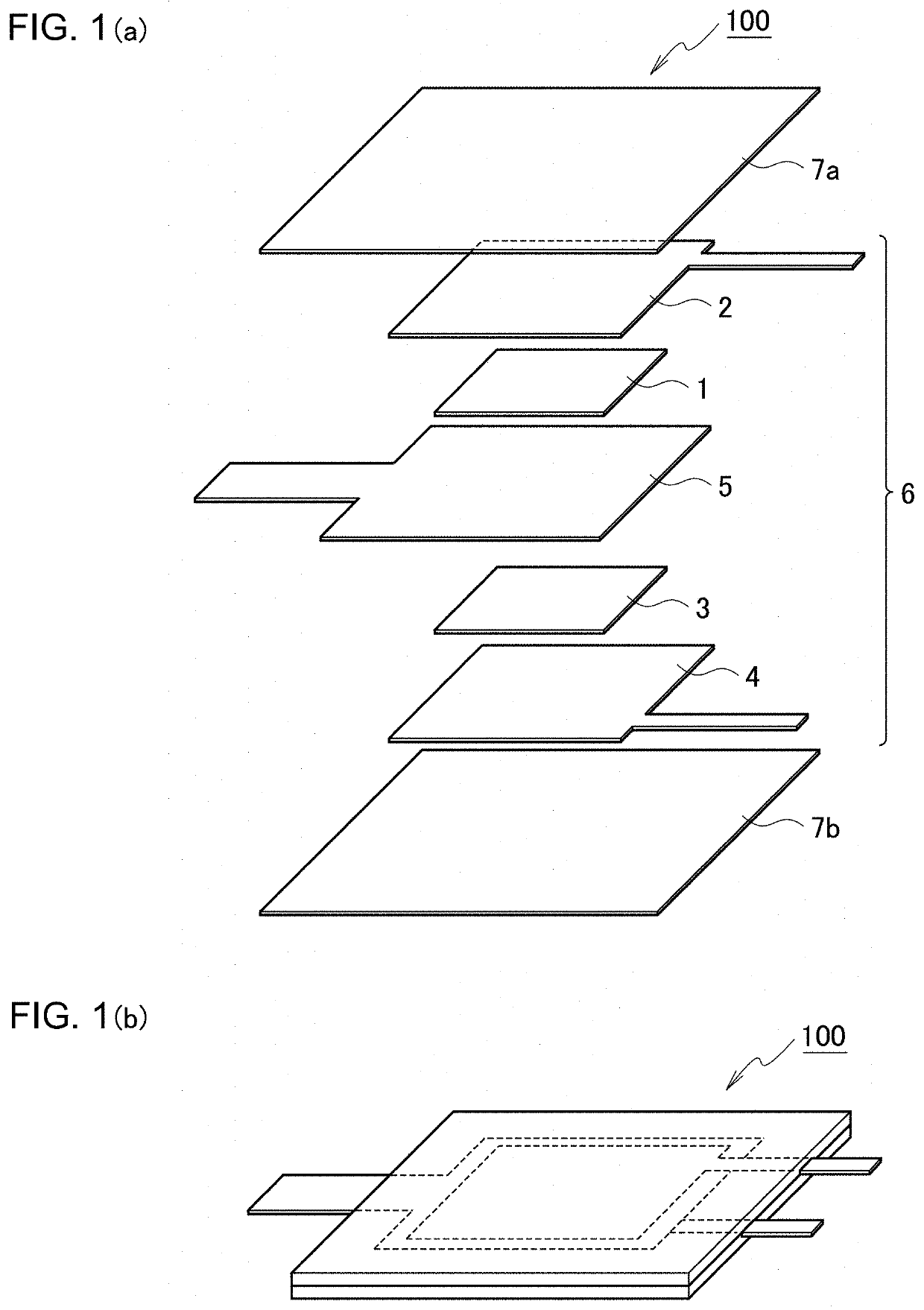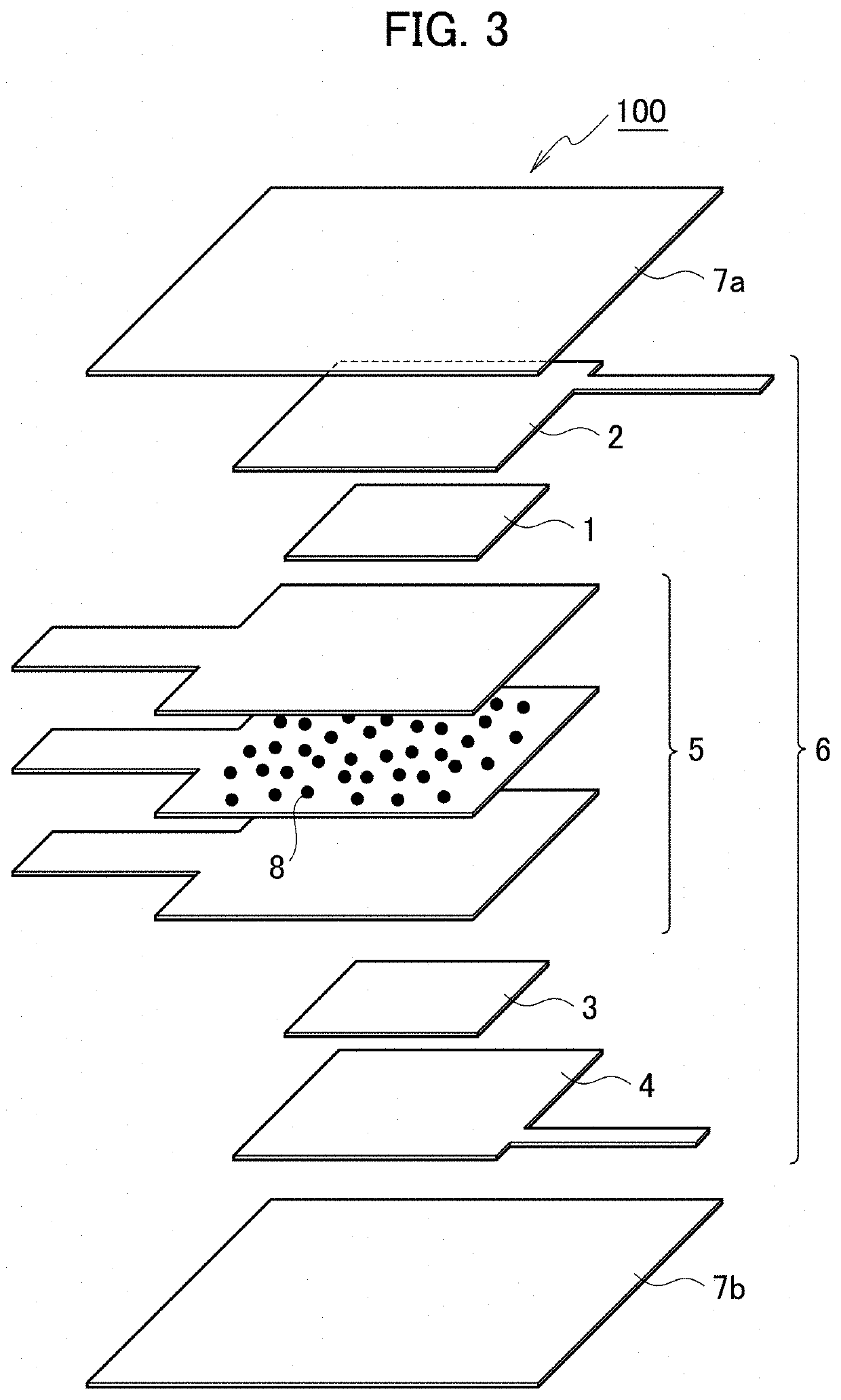Primary Battery and Moisture Sensor
a technology applied in the field of primary batteries and moisture sensors, can solve the problems of not being able to handle these conventional primary batteries, and achieve the effect of easy handling
- Summary
- Abstract
- Description
- Claims
- Application Information
AI Technical Summary
Benefits of technology
Problems solved by technology
Method used
Image
Examples
example 1
[0056]In example 1, a primary battery 100 in FIG. 1 including a positive electrode 1 made of carbon nanofibers was prepared.
(Preparation of Positive Electrode)
[0057]First, a method of preparing the positive electrode 1 will be described. A commercially available carbon nanofiber sol [dispersion medium: water (H2O), 0.4 weight %, manufactured by Sigma-Aldrich] was put into a test tube, and this test tube was immersed in liquid nitrogen for 30 minutes to completely freeze the carbon nanofiber sol. After the carbon nanofiber sol was completely frozen, the frozen carbon nanofiber sol was taken out and put into an eggplant shaped flask, which was dried in a vacuum of 10 Pa or less using a freeze dryer (manufactured by TOKYO RIKAKIKAI CO., LTD.) to obtain a stretchable bicontinuous material containing carbon nanofibers and having a three-dimensional network structure. FIG. 5 is an SEM (Scanning Electron Microscope) image of this stretchable bicontinuous material. It can be understood from...
example 2
[0067]In example 2, description will be provided for a case where the positive electrode 1 (made of a stretchable bicontinuous material containing carbon nanofibers and having a three-dimensional network structure) in example 1 carries a catalyst. In the following, the positive electrode 1 carries manganese oxide (MnO2) as a representative of the catalyst. Note that by changing Mn to a certain metal, a desired oxide can be carried as a catalyst.
[0068]A commercially available manganese (II) chloride tetra hydrate (MnCl2.4H2O, manufactured by KANTO CHEMICAL CO., INC.) was dissolved in distilled water and permeated into “a stretchable bicontinuous material containing carbon nanofibers and having a three-dimensional network structure” prepared by the method in example 1. Then, ammonia water (28%) was gradually added dropwise until the pH reaches 7.0 to neutralizes it and precipitate manganese hydroxide. To prevent chlorine from remaining in the precipitate, washing with distilled water ...
example 3
[0071]In example 3, the structure of the primary battery 100 was changed to the one in FIG. 2, and a charge / discharge test was conducted while electrolyte solution is being supplied to the exposed portion of the separator 5, as in example 2.
[0072]The method of preparing the primary battery 100 in example 3 is the same as the one in example 2. Here, the separator 5 contains the electrolyte 8. Specifically, a separator was immersed in electrolyte solution for 30 minutes to make the separator carry NaCl as an electrolyte and then naturally dried in the atmosphere for one hour to obtain the separator 5 containing the electrolyte.
[0073]After the exposed portion of the separator 5 exposed to the outside of the casing was made to absorb tap water, a discharge test was conducted while electrolyte solution is being supplied to the exposed portion. The average discharge voltage of the primary battery 100 is approximately 1.25 V, the discharge capacity is approximately 1470 mAh / g, and thus bot...
PUM
 Login to view more
Login to view more Abstract
Description
Claims
Application Information
 Login to view more
Login to view more - R&D Engineer
- R&D Manager
- IP Professional
- Industry Leading Data Capabilities
- Powerful AI technology
- Patent DNA Extraction
Browse by: Latest US Patents, China's latest patents, Technical Efficacy Thesaurus, Application Domain, Technology Topic.
© 2024 PatSnap. All rights reserved.Legal|Privacy policy|Modern Slavery Act Transparency Statement|Sitemap



